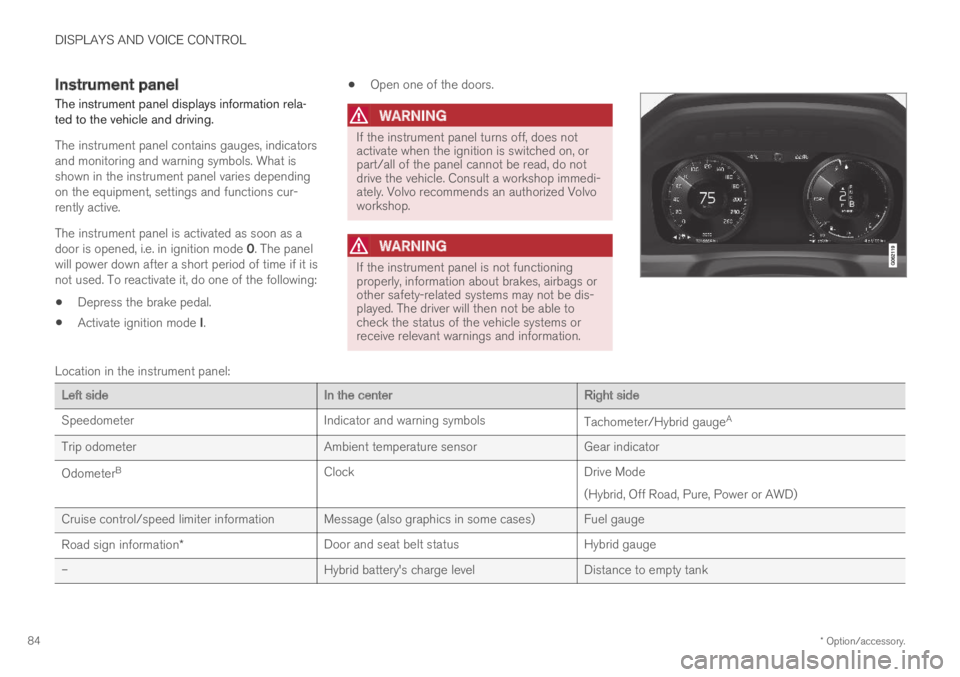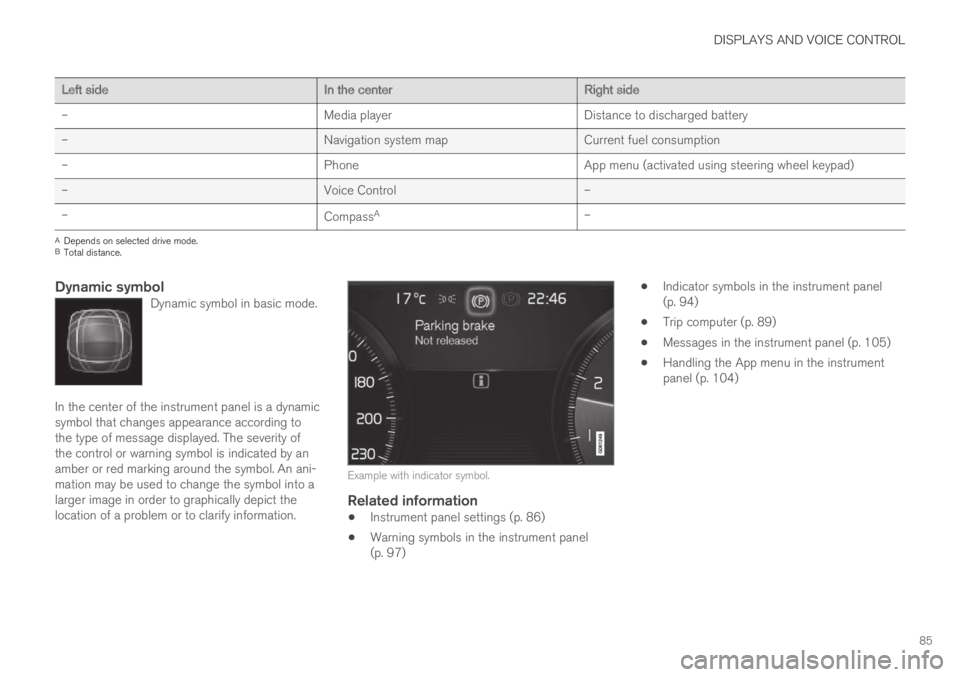2019 VOLVO XC60 TWIN ENGINE battery location
[x] Cancel search: battery locationPage 8 of 695

6
Preconditioning timer227
Adding and editing timer settings forpreconditioning227
Activating and deactivating precondi-tioning timer228
Deleting preconditioning timer settings229
Climate comfort retaining function230
Starting and switching off the cli-mate retaining function when parking230
Parking climate symbols and messages231
Heater232
Parking heater232
Additional heater232
Activating and deactivating the auxili-ary heater233
KEY, LOCKS AND ALARM
Lock indication236
Lock confirmation settings237
Remote key237
Locking and unlocking using theremote key240
Settings for remote and inside doorunlock241
Unlocking the tailgate using theremote key241
Remote key range242
Replacing the remote key's battery243
Ordering additional remote keys246
Red Key - restricted remote key*247
Red Key* settings247
Detachable key blade248
Locking and unlocking with detacha-ble key blade249
Electronic immobilizer251
Start and lock system type designations251
Keyless and touch-sensitive surfaces*252
Keyless locking and unlocking*253
Keyless unlock settings*255
Keyless tailgate unlock*255
Antenna locations for the start andlock system256
Locking and unlocking from insidethe vehicle256
Unlocking the tailgate from insidethe vehicle258
Activating and deactivating childsafety locks258
Automatic locking when driving260
Opening and closing the power tailgate*260
Setting a maximum height for thepower tailgate*263
Foot movement tailgate operation*264
Private Locking265
Activating and deactivating privatelocking266
Alarm267
Arming and disarming the alarm268
Page 86 of 695

DISPLAYS AND VOICE CONTROL
* Option/accessory.84
Instrument panel
The instrument panel displays information rela-ted to the vehicle and driving.
The instrument panel contains gauges, indicatorsand monitoring and warning symbols. What isshown in the instrument panel varies dependingon the equipment, settings and functions cur-rently active.
The instrument panel is activated as soon as adoor is opened, i.e. in ignition mode 0. The panelwill power down after a short period of time if it isnot used. To reactivate it, do one of the following:
Depress the brake pedal.
Activate ignition mode I.
Open one of the doors.
WARNING
If the instrument panel turns off, does notactivate when the ignition is switched on, orpart/all of the panel cannot be read, do notdrive the vehicle. Consult a workshop immedi-ately. Volvo recommends an authorized Volvoworkshop.
WARNING
If the instrument panel is not functioningproperly, information about brakes, airbags orother safety-related systems may not be dis-played. The driver will then not be able tocheck the status of the vehicle systems orreceive relevant warnings and information.
Location in the instrument panel:
Left sideIn the centerRight side
SpeedometerIndicator and warning symbolsTachometer/Hybrid gaugeA
Trip odometerAmbient temperature sensorGear indicator
OdometerBClockDrive Mode
(Hybrid, Off Road, Pure, Power or AWD)
Cruise control/speed limiter information Message (also graphics in some cases) Fuel gauge
Road sign information*Door and seat belt statusHybrid gauge
–Hybrid battery's charge levelDistance to empty tank
Page 87 of 695

DISPLAYS AND VOICE CONTROL
85
Left sideIn the centerRight side
–Media playerDistance to discharged battery
–Navigation system mapCurrent fuel consumption
–PhoneApp menu (activated using steering wheel keypad)
–Voice Control–
–CompassA–
ADepends on selected drive mode.BTotal distance.
Dynamic symbol
Dynamic symbol in basic mode.
In the center of the instrument panel is a dynamicsymbol that changes appearance according tothe type of message displayed. The severity ofthe control or warning symbol is indicated by anamber or red marking around the symbol. An ani-mation may be used to change the symbol into alarger image in order to graphically depict thelocation of a problem or to clarify information.
Example with indicator symbol.
Related information
Instrument panel settings (p. 86)
Warning symbols in the instrument panel(p. 97)
Indicator symbols in the instrument panel(p. 94)
Trip computer (p. 89)
Messages in the instrument panel (p. 105)
Handling the App menu in the instrumentpanel (p. 104)
Page 245 of 695

KEY, LOCKS AND ALARM
}}
* Option/accessory.243
Related information
Remote key (p. 237)
Antenna locations for the start and lock sys-tem (p. 256)
Keyless and touch-sensitive surfaces*(p. 252)
Replacing the remote key's battery
The battery in the remote key must be replacedwhen it is discharged.
NOTE
All batteries have a limited service life andmust eventually be replaced (does not applyfor Key Tag). The battery's service life variesdepending on how often the vehicle/key isused.
The remote key battery should be replaced if:
the information symbol illuminates andthe message Vehicle key bat. lowSee Owner's manual is displayed inthe instrument panel
and/or
the locks do not react after several attemptsto lock or unlock the vehicle using theremote key within approx. 20 meter (65 feet)from the vehicle.
NOTE
Move closer to the vehicle and try to unlock itagain.
The battery in the smaller key without buttons9
(the Key Tag) cannot be replaced. A new key canbe ordered from an authorized Volvo workshop.
CAUTION
An end-of-life Key Tag must be turned in toan authorized Volvo workshop. The key mustbe deleted from the vehicle because it canstill be used to start the vehicle via backupstart.
9This key is provided with vehicles equipped with keyless locking/unlocking (Passive Entry*).
Page 251 of 695

KEY, LOCKS AND ALARM
}}
249
Put the key blade back into its designatedspot in the remote key after use.
Replace the cover by pressing it downuntil it clicks into place.
Slide the cover back.
>An additional click indicates that the coveris correctly in place.
Related information
Locking and unlocking with detachable keyblade (p. 249)
Remote key (p. 237)
Locking and unlocking withdetachable key blade
The detachable key blade can be used to unlockthe vehicle from the outside, e.g. if the battery inthe remote key is discharged.
Unlocking
Pull the front left-hand door handle to its endposition to access the lock cylinder.
Put the key in the lock cylinder.
Turn the key clockwise 45 degrees so thatthe key blade is pointing straight rearward.
Turn the key blade back 45 degrees to itsoriginal position. Remove the key from thelock cylinder and release the handle so that itreturns to its original position against thevehicle.
5.Pull the door handle.
> The door will open.
Lock the door in the same way, but turn the key45 degrees counterclockwise in step (3).
Turning off the alarm
NOTE
When the door is unlocked using the detach-able key blade and then opened, the alarmwill be triggered.
Location of the backup key reader in the cup holder.
Turn off the alarm by:
1.Place the remote control key on the key sym-bol in the backup reader in the bottom of thecup holder in the tunnel console.
2. Turn the start knob clockwise and release it.
> The start knob will automatically return toits original position - the alarm signal willstop and the alarm will be turned off.
Page 271 of 695

KEY, LOCKS AND ALARM
269
Disarming the alarm without a functioning
remote key
The vehicle can be unlocked and disarmed evenif the remote key is not functioning, e.g. if thebattery is discharged.
1. Open the driver's door using the detachablekey blade.
> This will trigger the alarm.
Location of the backup key reader in the cup holder.
2. Place the remote key on the key symbol inthe backup reader in the tunnel console'scup holder.
3.Turn the start knob clockwise and release.
> The alarm will be disarmed.
Turning off a triggered alarm
–Press the unlock button on the remote keyor put the ignition into mode I by turning thestart knob clockwise and then releasing it.
NOTE
Remember that the alarm is armed whenthe vehicle is locked.
The alarm will be triggered if any of thedoors is opened from the inside.
Automatically arming and disarming the
alarm
Automatically arming the alarm helps preventinadvertently leaving the vehicle without alarmprotection.
If the vehicle is unlocked using the remote key(and the alarm is disarmed) but none of thedoors or tailgate are opened within two minutes,the alarm will be automatically rearmed. The vehi-cle will also re-lock.
On some markets, the alarm will be automaticallyarmed following a slight delay after the driver'sdoor has been opened and closed without beinglocked.
To change this setting:
1.Tap Settings in the center display's Topview.
2.Tap My CarLocking.
3.Select Passive Arming Deactivation totemporarily deactivate the function.
Related information
Alarm (p. 267)
Page 423 of 695

HYBRID INFORMATION
}}
421
Charging status in the vehicle'scharging socket
The charging status is indicated by an LED lightin the charging socket.
Location of the LED indicator light in the vehicle'scharging socket.
The LED indicator light shows the current chargestatus during charging. If the LED indicator lightis not illuminated, check to make sure the cableis securely connected in the wall outlet and in theoutlet in the vehicle. A white, red or yellow lightilluminates when the passenger compartmentlighting is activated and will remain illuminated fora short time after the passenger compartmentlighting has gone out.
LED indicatorlight's colorMeaning
WhiteCourtesy light.
YellowWait modeA – waiting forcharging to start.
Flashing greenCharging is in progressB.
GreenCharging completedC.
RedMalfunction.
AE.g. after a door has been opened or if the charging cable han-dle is not locked in place.BThe more slowly the light flashes, the closer the battery is tobeing fully charged.CThe light will go out after a short time.
Related information
Charging the hybrid battery (p. 413)
Charging status in the instrument panel(p. 423)
Charging status in the charging cable'scharging module (p. 421)
Stopping hybrid battery charging (p. 425)
Charging status in the chargingcable's charging module
The red and blue lights in the charging moduleindicate the status of ongoing and completedcharging.
Charge module: 1. Red warning light, 2. Blue status indi-cator
When the charge module is initially plugged intoa wall outlet, the red warning light will flash onceto indicate that a startup safety check has beenperformed. When the safety check has beencompleted, the blue status indicator will glowsteadily and the red warning light will be off. Thecharger is now ready to be used. If the red warn-ing light continues to flash or glows steadily, afault has been detected and the charger will notdeliver power to the vehicle. Contact a Volvoretailer or a certified Volvo service technician.
Page 430 of 695

HYBRID INFORMATION
428
Long-term storage of vehicles withhybrid batteries
To help minimize degradation of the hybrid bat-tery if the vehicle is not driven for a prolongedperiod (longer than 1 month) the hybrid batterycharge level should be kept at approx. 25%according to the gauge in the instrument panel.
Do as follows:
1. If the hybrid battery charge level is high, drivethe vehicle until the charge level is approxi-mately 25%. If the charge level is low, chargethe battery until the level reaches approxi-mately 25%.
2.If the vehicle is not driven for more than 6months or the hybrid battery's charge level isnoticeably below the 25% mark, charge thebattery to about 25% to help compensate forthe natural battery discharge that occurs inlong-term storage. Regularly check thecharge level using the gauge in the instru-ment display.
NOTE
Store the vehicle in as cool a location as pos-sible to minimize battery aging during long-term storage. In the summer, park the vehicleindoors or in a shady location, whichever iscooler.
Related information
Initiating hybrid battery charging (p. 419)
Hybrid gauge (p. 88)
Charging the hybrid battery (p. 413)